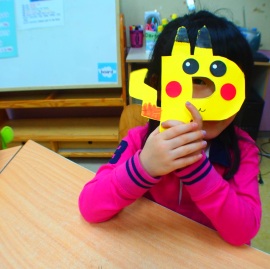So as my last post showed we’ve been studying letters and making a craft for each letter. We reached P and I didn’t like a lot of the other crafts out there. P is for pirate is cool but a bit lost on my Korean students. P is for Parrot, but I couldn’t get that many feathers in time. Pig and puzzle just bore me so what could really WOW my kids… and me…
 Pikachu! Something they all know, love, and idolize! P is for Perfect! Well I know it says Pokemon, that’s a little mistake on my part printing out Pokemon instead of Pikachu, but I didn’t want to waste anymore paper and reprint the whole thing. Besides the only words my class can read is: I, a, can, is and, you.
Pikachu! Something they all know, love, and idolize! P is for Perfect! Well I know it says Pokemon, that’s a little mistake on my part printing out Pokemon instead of Pikachu, but I didn’t want to waste anymore paper and reprint the whole thing. Besides the only words my class can read is: I, a, can, is and, you.
No tutorials for P is for Pikachu so here is how I made mine.
First off, for those of you that live without Pokémon , Pikachu is a rodent like Pokémon that is the main mascot for the Pokémon franchise and also one of the main representative of Nintendo’s cast of characters.
First, you need a P. For all my letters I have been using the uppercase letters and use about.com’s list of letter coloring pages. You can also image search P letter coloring page.
Glue this to some thin cardboard (like a cereal box) and cut out for a reusable template. I also did the same with the tail and ear. I free handed both the tail and ear so sorry for no links for those. I guess you could find a picture of Pikachu and use those as a template.

I used a 1 inch hole punch for the red cheek circles and black eye circles. Just used a regular hole punch for the whites of the eyes.
Color ears and tail and add a sideways 3 for a mouth. Now you have a fun way to teach P!
Here are some of my kids and their Pikachu!





































